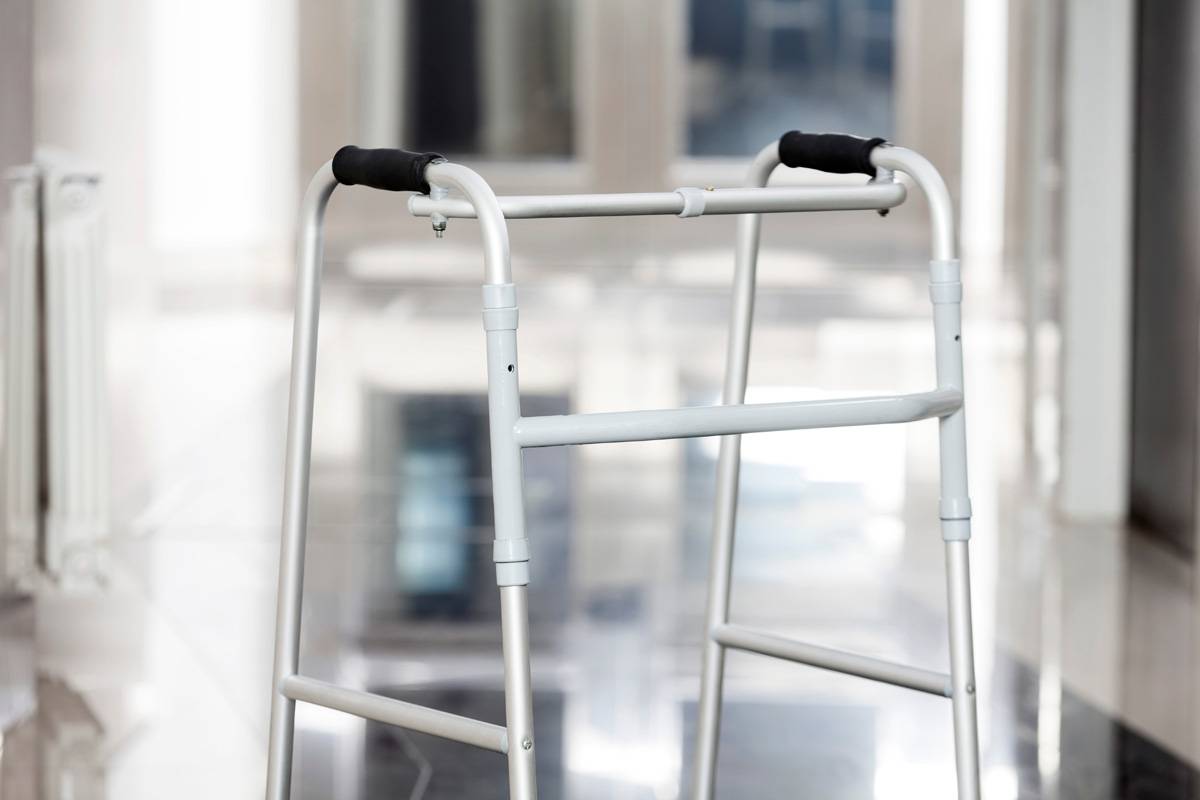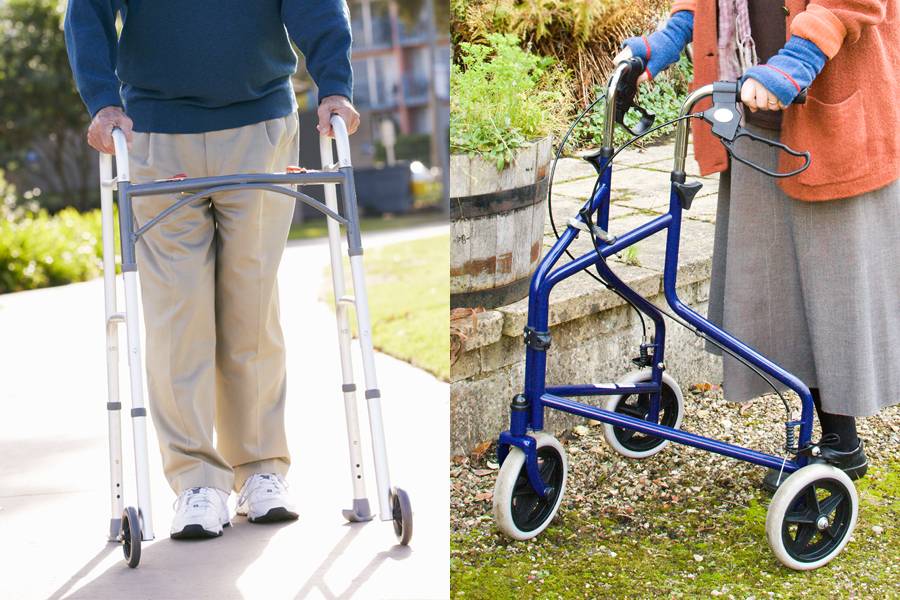


If you have noticed recently that your loved one has difficulty moving from one place to another either as a result of old age or a recent disability.
A quick online search for a walking aid to help with their mobility issues throws up different types of walking aid that could leave you feeling confused.
How can you power through the many options to decide on a type that is just right for your loved one? This article cuts through the noise in an easy-to-follow way and helps you in making the right purchase.
Who Needs Walking Frames?

Walking frames are not for everyone with mobility issues. They are only really suitable for the following categories of people:
Benefits Of Zimmer Frames And Rollators

Zimmer frames and rollators offer lots of benefits to its users that set them apart from other walking aids. Those benefits include the following:
1 Reduces pain and fatigue
These frames redistribute weight from the legs of its users to the arms of the walking aid and away from the body. This weight distribution results in fatigue and body pain reduction.
2 Enhances confidence
These mobility aids give a semblance of independence to people with mobility concerns. Since they don’t have to depend on others to aid with their movement, it significantly enhances their self-confidence.
3 Provides stability
Walking frames provide users with a wide support base which leads to greater balance and stability.
4 Improves safety
Walking frames are designed to be strong and durable to withstand the users’ weight. They also provide a level of support so your loved one does not have to worry about falling or slipping when using them.
What Are Zimmer Frames?

Zimmer frame is the popular name for walkers without wheels. Zimmer is a brand synonymous with walking frames, in the same way Dyson is associated with vacuum cleaners.
These types of frames are usually constructed with four legs to make them extremely stable. However, you can still find Zimmer frames with three legs.
Rubber caps (ferrules) are attached to the bottom of each leg to keep the frame from sliding and causing an accident. Zimmer frames also have hand-grips made of foam rubber or moulded plastic to provide a solid grip that is not strenuous for its users.
Since having a walker set to the correct height of your loved one is important, Zimmer frames usually come in either adjustable or fixed heights.
Types of Zimmer frames
Zimmer frames come in several widths and sizes. Once you can differentiate the types from each other, you are well on your way to choosing the most suitable aid for your loved one.
1 Folding frames
Folding frames have joints that can be folded into a flat shape when their catch mechanisms are released.
The catch mechanisms usually differ from one foldable frame to another. This causes some users to complain of their inability to easily activate the catch. To prevent this, check the mechanism of your chosen frame to ensure your loved one can comfortably operate the catch mechanism before buying.
Folding frames are ideal for people with little or no storage space as they do not take up room in a house or car boot.
2 Reciprocal frames
Unlike folding frames with static joints, reciprocal frames have swivel/pivot joints that move each side of the frame alternatively instead of at the same time. In other words, instead of lifting the entire walker, the user only needs to move one side of the frame at a time.
Due to its similarities to walking naturally, it is a favorite with many users. However, these frames can sometimes be tricky to learn how to use one. So, before settling for this frame, it is recommended that you consult a physiotherapist or occupational therapist about its suitability for your loved one.
3 Forearm frames
These frames are just normal Zimmer frames but with a key difference. Whereas the other frames listed have handgrips, forearm frames, in contrast, have padded forearm support (referred to as a gutter or trough).
As a result, users can bear the bulk of their weight on their forearms rather than hands. Forearm frames are ideal for people with arthritic hands or reduced grip ability.
This Weeks Most Popular Zimmer Frames
[amazon bestseller=”zimmer frames” description_items=”3″ description_length=”100″ button_text=”Buy Now” items=”3″]
What Are Rollators?

Due to the absence of wheels in Zimmer frames, people have to lift and move the frame forward whenever they take a step. This introduces an additional action (and therefore effort) to move and some users rightly find this mode of walking more tiring. So, to make walking more fluid and natural, the rollator was born.
Since a rollator is just an advanced walking frame with wheels, it can also be called a wheeled walker. The frame of a rollator usually has handlebars, a seat, and tyres.
Some rollators might even come with a shopping basket. Due to their bulkiness and large wheels, rollators are mostly used outdoors. But there are smaller rollators that can be used indoors. Four-wheeled rollators are the most popular variety due to their stability.
Types of rollators
Shopping for a rollator will turn up the following types:
1 Three-wheeled rollators
In contrast to the bulky four-wheeled rollators, the three-wheeled rollator is lighter and easy to maneuver. It is made in the form of a tricycle with two uni-directional wheels at the rear and a swivel caster in front for easy rolling and turning.
Usually, these rollators are fitted with a shopping basket which is placed at the front. Three-wheeled rollators are perfect for those who want faster movement. However, even though they offer greater mobility, they are less stable when compared to the four-wheeled variety.
2 Four-wheeled rollators
These rollators have large swivel casters and wheels that make walking more natural. They are bulky and sturdy enough to bear the entire weight of its user without fear of losing balance.
In addition, these rollators are equipped with seats for resting. There are even models that have a storage area under the seat or a tray which can be useful for holding things.
This Weeks Most Popular Rollators
[amazon bestseller=”rollator” description_items=”3″ description_length=”100″ button_text=”Buy Now” items=”3″]
Features To Consider Before Buying A Zimmer Frame Or Rollator

Walking frames feature specifications and feature parts that can be difficult to understand. Knowing how pricey walking frames can be, this section lists out the important features you should check before investing in one.
1 Material
All walking frames are usually made out of either aluminium or stainless steel, with aluminium being the most common.
If you want a frame that can withstand heavy usage, then look for a walking aid made out of stainless steel. Unlike aluminium, stainless steel frames are much stronger and weigh more.
2 Height
The height of your ideal frame should be perfect; neither too low nor too high.
If it’s too low, it can result in poor posture as a result of bending over. With too high frames, it might be hard for your loved one to fully stretch out their elbows.
To prevent any of this occurring, ensure your loved one is measured while wearing their everyday footwear.
3 Seats
Seats come in handy after long, tiring walks. So, if you are opting for rollators, ensure that the seats are comfortable and well-cushioned. Is the height of the seat too low or is it too high? Is the seat narrow, wide, or just right?
Rollators that come with armrests and backrest, to make sitting comfy, should also be considered. In any case, note that seats are an additional weight on walking frames.
4 Weight
The stability and balance of weighty frames make them a popular choice for most users. But apart from the neck and shoulder ache caused by constantly lifting these steel-reinforced frames, they may be too heavy for your loved one to lift.
Therefore, before buying a walking frame, do factor in the ability of your loved one to conveniently lift it without tiring.
5 Brakes
Brakes, a constant feature on rollators, are used to control walking speed. It is highly recommended that your choice of rollators should have brakes that are easy to operate and always within reach. The types of brakes you will find are:
- Cable brakes: These brakes function just like bicycle brakes; they require squeezing before they can be applied. Cable brakes are not suitable for persons with pain or stiffness in their hands.
- Pressure brakes: Here, the brake feature is engaged when it is pressed down. Persons with weak wrists might find it difficult to operate.
6 Width
The appropriate width is usually determined by the size of your loved one and the environment the frame will be used. For indoor usage, measure the doors in your house. Now, allow for 2-inches, at least, on both sides of the walking frame. Doing this will allow your loved one to easily move through doorways.
7 Wheels
Where the rollator will be used will determine what type of wheels to go for. Small wheels are ideal indoors while for outdoor usage, go for larger wheels.
How To Choose A Zimmer Frame Or Rollator

Knowing the features of your preferred walking frame is just one aspect of making an informed choice. However, the following factors are equally important in choosing a walking frame.
1 Know your storage capacity
Do you have enough space to store a bulky rollator? Will you need to frequently transport the walking frame from one place to another?
Foldable frames should be considered when storage space is small. In addition, if your loved one likes to shop, rollators with baskets and storage units are ideal.
2 Consider your location
Where will your loved one be using the frame? Will it be indoors or outdoors? Zimmer frames are the preferred option for indoors while rollators are perfect for the outdoors.
3 Recognize the terrain
In addition to the location, terrain plays an important role in your choice of walking frame. Opting for small-wheeled frames in carpeted areas requires more exertion to push than large wheels. Also, large wheels can navigate uneven grounds without any problem.
Frequently Asked Questions
The answers in this section provide clarity to any lingering questions you might have about the walking frames featured in this article.
Should I get a Zimmer frame or a rollator?
Before shopping for a walking frame, it is advisable that you consult your GP or physiotherapist for an initial assessment. Their input on whether you need a mobility aid and what type, can aid you in the long run.
What if the walking frame cannot hold up my size?
Most walking frames come with a pre-determined weight limit to ensure maximum safety. To allay your concerns, simply ensure that you do not exceed the weight limit of your walking frame.
What safety tips should I observe when using a walking aid?
- To prevent slippage or fall, don’t use your walking frame on wet floors.
- Be extra careful when going through areas with clutter, loose rugs, carpet, or mats.
- Your choice of footwear should be fitting, supportive, and functional.
- Don’t climb stairs with walking frames. If your home has stairs, get two frames; keep one frame downstairs and the other upstairs.
- Ensure your walking frame is well maintained at all times by regularly checking for signs of wear and tear.
How can I maintain my walking frame?
- Look closely at your walking frame and check for any cracks or rust.
- Pay special attention to the ferrules (rubber cap) attached to the ends of Zimmer frames. Due to constant friction and outside exposure, the bobbles or slip-resistant rings on the ferrules could lose definition and crack. When you notice this, have it replaced immediately.
- Weather conditions also cause damage in outdoor equipment, and walking frames are no exception. If rust forms on your frame, it causes a reduction in its core strength and makes it hazardous. At the first sign of rust, take it to the place you bought it from for added protection.
Can I buy a walking aid without input from my GP or physiotherapist?
It is possible but not recommended.
Since your posture, muscle strength, and gait can change due to long term use of these frames, a licensed professional will ensure the following:
- Choosing the right walking frame for you.
- Setting your frame to the appropriate height.
- Teaching you how to use it properly.
- Ensuring you engage in activities like exercise to forestall any adverse changes in your body as a result of using the frame.
Conclusion
Zimmer frames and rollators provide balance, support, and stability to individuals with different needs. Getting the correct fit can be the difference between pleasurable movement and walking wracked by pain.
Hopefully, this guide should come in handy in helping you make the perfect selection. Please bookmark this page for future reference and share it with those you feel might find it useful.





